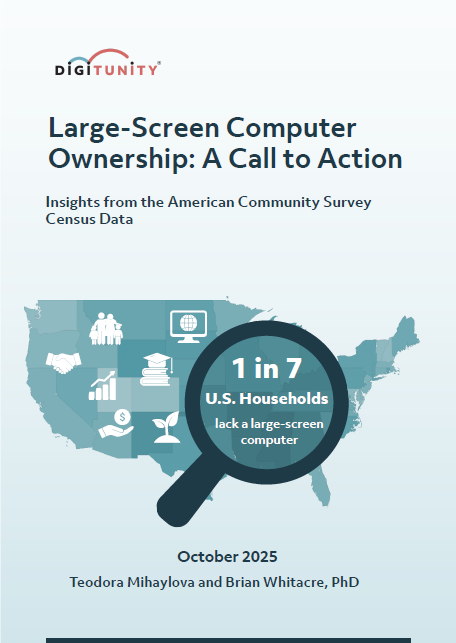Wednesday, October 15, 2025
Digital Beat
New research released by Digitunity this week explores the key role devices play in bridging the digital divide. 
Since 2013, the Census Bureau has asked three questions in the American Community Survey related to computer and internet use, focused on the type of computing device used (if any), if the household is connected to the internet, and via what type of internet connection. One in seven households either have no computer at all or rely only on a smartphone for internet access. While smartphones provide convenient internet access and can be more portable and affordable than computers, they lack the functionality of large-screen computers. Access to large-screen computers (think laptops, desktops, and tablets) ensures continuous, on-demand access that a borrowed, shared, or public device doesn’t allow. A large-screen computer enables:
Access to learning opportunities and earning educational and workforce credentials.
Expanded options for employment, including remote work.
Achieving upward economic mobility and long-term financial stability.
Participating in community decisions and having their voices heard.
Increased connection by being part of their community and reducing social isolation.
Improved physical and mental health through access to healthcare and health information.
Increased personal agency by finding and using information to make informed decisions about their lives.
While smartphones provide convenient internet access, they cannot fully replace large-screen computers. Research demonstrates that large-screen computer ownership is critical for unlocking beneficial internet activities.
Key Benefits of Large-Screen Computer Ownership
Education: Students with home computer access are 4-6% more likely to graduate high school and score 3-5% higher on tests
Employment: Computer owners earn $2,800-$6,800 more annually and have 7-12% higher weekly employment rates
Remote Work: 37% of U.S. jobs can be performed remotely, accounting for 46% of all wages, but these require computer access
Healthcare: Essential for telehealth appointments, accessing electronic health records, and managing chronic conditions
Digital Skills: Computer ownership leads to substantially higher basic, medium, and advanced computer skills
College Enrollment: Computer owners have 12-16% higher college enrollment rates
The Smartphone-Only Limitation
Smartphone-only users experience a limited and unequal internet experience. They face challenges with:
Editing documents and completing online forms
Participating in video conferences (Zoom calls)
Accessing financial management software
Developing comprehensive digital literacy skills
Managing complex online tasks required for education and employment
The Scale of the Problem
A significant transformation has occurred in how American households access technology between 2016 and 2023:
Total households without large-screen devices decreased 14.79% (from ~21.2 million to ~18 million).
Households with no computer at all dropped dramatically from 12.74 million to 5.06 million.
Smartphone-only households increased nearly 54 percent, adding over 4.5 million households.
This represents a shift from “no digital access” to “limited digital access”—a positive trend that still leaves millions without the tools needed for full digital participation.
Nationally, 1 in 7 American households, or approximately 13.75% of U.S. households—representing 18,053,299 households—either lack a computer at home or rely solely on a smartphone for internet access. According to the Census Bureau analysis, this translates to 33,268,817 residents who are without access to any type of computing device or who rely exclusively on a smartphone to go online.
A household in Mississippi is three times more likely to lack a large-screen computer than a household in Utah.
Mississippi reported the highest need for computers, with 24.19% or 1 in 4 households without a large-screen computer. Similarly, high rates were seen in West Virginia (22.46%), Louisiana (21.97%), and Arkansas (21.92%). In Alabama, Kentucky, and Oklahoma, nearly 1 in 5 households faced similar challenges.
Conversely, in 2023, states with the lowest rates of households without large-screen computers include Utah (8.22%), Colorado (8.69%), New Hampshire (9.12%), Washington (9.21%), and Idaho (9.95%). Puerto Rico experienced the most significant digital divide, with nearly 40 percent of households—over half a million households—lacking any computer or relying solely on a smartphone for internet connectivity
Who Is Most Affected by the Device Divide? A Demographic Analysis
National averages for device ownership mask differences across various demographic groups. For example, there are wide variations in no computer and smartphone-only access across age categories, racial groups, levels of educational attainment, and employment status.
Age
Older adults (65+) face the greatest challenges:1
7.2% lack any type of computing device (5x higher than adults 18-64)
10.3% are smartphone-dependent
Access drops significantly after age 75, and even further after age 81
However, this represents dramatic improvement: in 2016, 20.2% of elderly residents lacked any computer
Race and Ethnicity
Lack of Any Computer (2023):
American Indian/Alaska Native: 3.8%
African American: 3.3%
Native Hawaiian/Pacific Islander: 3.1%
White: 2.5%
Asian: 1.1%
Smartphone-Only Access (2023):
“Other race”: 22.4%
American Indian/Alaska Native: 13.5%
Hispanic/Latino: 12.5%
African American: 11.4%
White: 6.1%
Asian: 4.4%
Educational Attainment
Education level strongly correlates with computer ownership.
People without a high school diploma are 10 times more likely to lack a computer than those with a bachelor’s degree.
Individuals 25+ Without Any Computer:
Less than high school: 8.6%
High school/some college/associate’s: 3.4%
Bachelor’s degree or higher: 0.9%
Smartphone-Only Access:
Less than high school: 20.5%
High school/some college/associate’s: 10.2%
Bachelor’s degree or higher: 2.4%
Employment Status
Labor force participation significantly impacts computer access.
Individuals 16+ Without Any Computer:
Not in labor force: 5.6%
Unemployed: 1.7%
Employed: 1.2%
Those not in the labor force (students, homemakers, retired workers, etc.) are over 4.5 times more likely to lack computer access compared to employed individuals.
The Economics of Computer Access: Income and Poverty as Primary Drivers
Statistical analysis reveals strong correlations between economic factors and computer ownership.
Median Household Income:
Strong negative correlation with a lack of large-screen computers
For every $10,000 increase in median household income, households without large-screen devices decrease by 1.42%
Poverty Rates:
Very strong positive correlation with lack of computer access
For every 1% increase in poverty rates, households without large-screen computers increase by approximately 1%
When controlling for multiple variables, the research finds:
Households without any computer are more likely to be in poverty, aged 65+, and are not in the labor force
For smartphone-only households:
Median household income is the most influential variable
As income rises, smartphone-only access decreases
No other demographic factors show strong independent effects
This analysis demonstrates that device access is fundamentally an economic issue, with income and poverty being the primary determinants of who has access to large-screen computers.
Is Universal Computer Ownership Possible?
Digitunity has developed a systems-level approach to address the persistent barriers that prevent computer ownership and offers the following recommendations.
At the National Level:
Cultivate and share knowledge about effective strategies
Enact policies prioritizing computer ownership as essential infrastructure
Integrate healthcare, education, and workforce development sectors
Mobilize large-scale financial and in-kind resources
Document and share learnings from local initiatives
At the Local Level:
Identify existing assets and resource gaps
Mobilize local financial and in-kind resources
Prepare and make computers readily available
Promote alignment among community stakeholders
Continuously learn and incorporate residents’ lived experiences
Legislative efforts should prioritize:
Older adults (65+): Programs that equip elderly individuals with devices and digital skills.
Racial and ethnic minorities: Targeted interventions for communities with the highest gaps.
Low educational attainment: Focus on individuals without high school diplomas.
Not in labor force: Support for students, homemakers, and job seekers.
Address Affordability
Federal and state programs offering free or low-cost computers to eligible individuals.
Particular focus on households below or at the poverty line.
Corporate device donation programs aligned with community needs.
Technology refurbishment and reuse programs supporting a circular economy.
State and Local Action
Use Census data to identify communities with the highest need.
Design policies addressing community technology needs through targeted resource allocation.
Incentivize private sector technology donations.
Coordinate across sectors (healthcare, education, workforce development).
Future Research Needs
Deeper data analysis: Utilize Current Population Survey (CPS) Computer and Internet Use Supplement
Rural vs. urban gaps: Explore geographic disparities in more detail
Quality and functionality: Study device quality, software requirements, and digital literacy training needs
Causal relationships: Conduct randomized controlled trials to establish concrete benefits of computer ownership
Special populations: Examine needs of people with disabilities, homeless individuals, and migrant workers
The Digital Divide is About Access to the Right Tools
The digital divide in America is not just about internet connectivity—it’s fundamentally about access to the right tools. Between 2016 and 2023, millions of households gained access to computing devices, demonstrating that progress is possible. Achieving universal computer ownership requires:
Sustained political will and policy support
Economic interventions targeting affordability
Coordinated ecosystems bringing together diverse stakeholders
Targeted programs for highest-need populations
Long-term commitment beyond individual funding cycles
The stakes are high: without large-screen computers, millions of Americans cannot fully access education, earn competitive wages, manage their health, or participate in their communities. Closing this divide is not just a matter of equity—it’s an economic and social imperative for the nation’s future.
For the complete report with detailed methodology, statistical analysis, and state-by-state data, see the full document: Large-Screen Computer Ownership: A Call to Action.
Notes
Census data excludes those in nursing homes and other group quarters, likely underestimating true need among the elderly.

